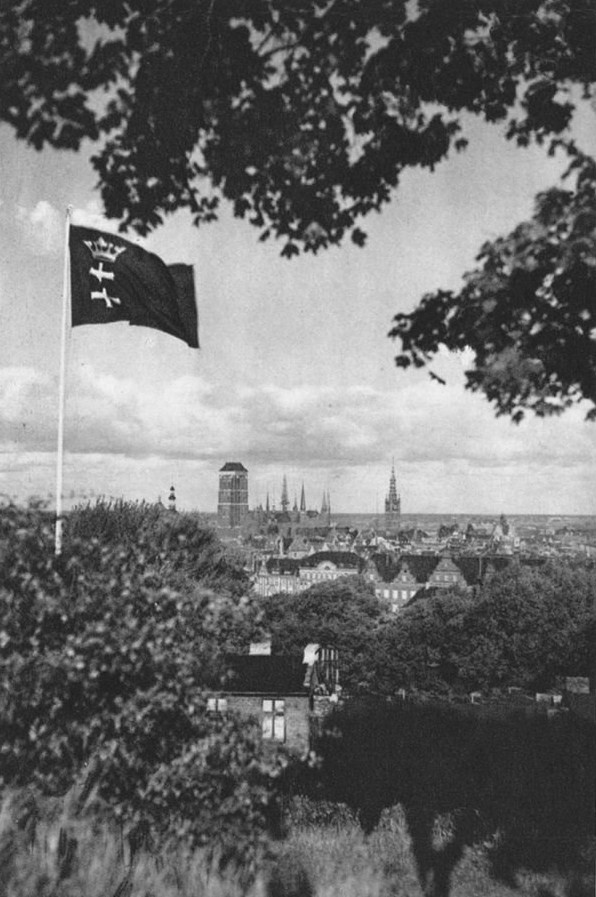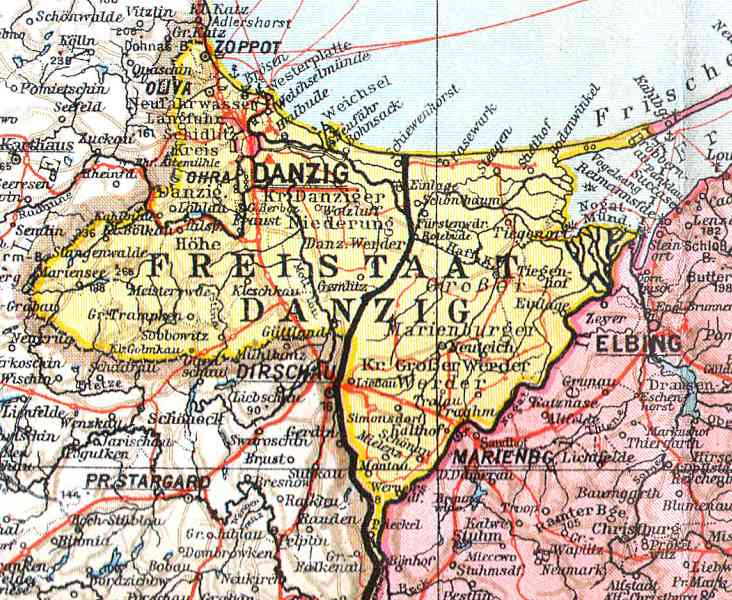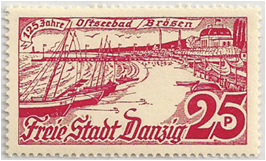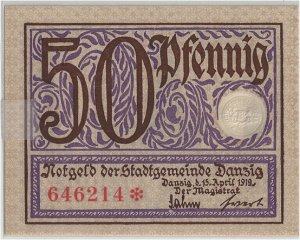ALBUM 1 – View my Danzig album 1 (regular issues)
ALBUM 2 – view my Danzig album 2 (Back of Book plus banknotes)
Fast Facts
Region: Germany / Poland Area
Group: Poland Area
Classification: Semi-autonomous State
Prior Regime: German Empire
Key Dates:
1920, Nov 15 – Free City of Danzig established
1933, May – Election of the National Socialist (Nazi) government in Danzig
1939, Sept 1 – Germany invades Poland
1939, Sep 2 – Danzig annexed by Germany
Following Regime: Danzig, German Administration in WW2
Scott Catalogue: (Danzig) #1-240, B1-B32, C1-C45, J1-J47, O1-O52
Pick Catalogue: (Danzig) #13-64
History

The Free City of Danzig (today Gdańsk) is located on the Baltic Sea and has a long history of industry and shipbuilding. After the defeat of Napoleon in 1815, Danzig became a part of the Kingdom of Prussia, and then part of the German Empire when it was created in 1871.
Following the defeat of Germany in World War 1, the Allied powers decided to create the Free City of Danzig (under a commissioner appointed by the League of Nations). Since the population of the city was predominantly German, it was not placed under Polish sovereignty, but as a semi-autonomous state under the protection of the League of Nations. The residents of the Free City governed its own internal affairs, but external affairs were put under Poland, which included a binding customs union which assured Poland an access to the sea. Danzig had its own constitution, national anthem, parliament and government. It issued its own stamps and currency.
As with the rest of the former German Empire, the 1920’s brought a period of hyperinflation and a great Depression, causing severe hardship in Free State. This hardship was made even more difficult by a trade war between Poland and Germany from 1925 to 1934. With the rise of the Nazi party in Germany, the German population of Danzig followed suit. Elections in May of 1933, the National Socialist Party was swept into power, creating an even closer alignment to the movement in Germany. In 1934, a German–Polish Non-Aggression Pact was signed and the Free City’s government was ordered by the Nazis to improve relations with Poland. Danzig and Poland entered a brief period of economic cooperation and prosperity, but the Nazi’s began to increase its suppression of the democratic opposition and discrimination of Jews and Poles in the City State. This discrimination resulted in the exodus of the Jewish population in the area, and by September of 1939, barely 1,700 mostly elderly Jews remained. (they were later deported to the ghettos of Warsaw).
 Following the annexation of Austria and the Sudetenland to Germany in October 1938, the German régime urged Danzig’s cession to Germany. On 1 Sept, 1939, Nazi Germany invaded Poland, initiating World War II. The very next day, 2 Sept, Germany officially annexed the Free City. The Nazi regime murdered the Polish postmen defending the Polish Post Office: this was one of the first war crimes during the war. Polish soldiers in the Free State defending the Westerplatte stronghold, but surrendered after seven days of fighting. Danzig, for the duration of World War 2, remained under German Control.
Following the annexation of Austria and the Sudetenland to Germany in October 1938, the German régime urged Danzig’s cession to Germany. On 1 Sept, 1939, Nazi Germany invaded Poland, initiating World War II. The very next day, 2 Sept, Germany officially annexed the Free City. The Nazi regime murdered the Polish postmen defending the Polish Post Office: this was one of the first war crimes during the war. Polish soldiers in the Free State defending the Westerplatte stronghold, but surrendered after seven days of fighting. Danzig, for the duration of World War 2, remained under German Control.
Stamps
 ALBUM 1 (regular issues)
ALBUM 1 (regular issues)
ALBUM 2 (Back of Book plus banknotes)
Prior to the creation of the Free State, stamps of the German Empire were used. The first stamps of the Free State issued in 1920, consisted of German stamps overprinted “Danzig”. Various overprints, surcharges and varieties of these stamps were issued, including stamps different configurations and colors of a fine network of lines or dots printed on face of the stamp called “burelage”. This was usually done to discourage counterfeiting or the reuse stamps. On 30 Jan, 1921, Danzig issued its first stamps featured a Hanseatic League trading ship design. This was commemorating the fact that Danzig was a member of the old Hanseatic League, and somewhat a swipe at the League of Nations who refused Danzig’s request to be named the “Free Hanseatic city of Danzig”
Between 1921 and 1922, two different designs containing the Danzig Coat of Arms were introduced. The first being a large coat of arms in an octagonal frame, and second the coat of arms bordered on each side by lions. From 1921 – 1923, a great inflationary period set in across Europe, and many denominations were continually issued, and ultimately the ramped inflation required them to be overprinted. The highest stamp issue for Danzig being 100 million marks.
On 31 Oct, 1923, a total revaluation and systemic conversion to the Gulden to replace the Mark, gave Danzig a much needed stability. In 1924, Danzig issued a new set of definitive stamps, which was a primarily a redesign of its large coat of arms stamp, but this time in an oval frame. This design was used as a definitive issue through 1939, when Danzig was annexed into Germany. Various commemorative stamps were issued during this period, including commemorative issues for the July, 1929 Philatelic Exhibition, and Souvenir sheets for the June, 1937 Philatelic Exhibition held in Danzig.
Danzig issued various sets of semi-postal stamps which including raising funds for tuberculosis, helping the poor, and annually between 1934-1937 providing aid to those in need for the severe winters in Danzig.
Danzig also issued Airmail stamps. In 1920, the first air-post stamps were stamps of Germany, surcharged and overprinted with an airplane and Danzig. Beginning in 1921, Danzig issued various versions of an “airplane over Danzig” design which was used until a new, more modern airplane design was released in 1935. In 1932, Danzig surcharged and overprinted “Luftpost – Ausstellung” meaning “Air-post-Exhibition” on its popular “sights around Danzig” issues for the International Airmail Exhibition in Strassburg.
Special Stamps for official mail were issued from 1921-1925. Until 1924, Danzig coat of arms issues were overprinted “D M” , which is a German abbreviation for Dienstmarke, meaning “official stamp”. In 1924, the newly designed coat of arms issues in Guilden were overprinted “Dienst-marke”.
Postage due stamps were also issued.
Following the annexation by Germany in 1939, Stamps of Danzig were overprinted Deutfches Reich” in black, and some included surcharges. These stamps were valid throughout Germany
Banknotes
 Prior to the formation of the city state, German currency was used, but various local banknotes were issued (Pick #1-12), primarily notgeld, local emergency money, issued during World War 1. Upon the creation of the Free State, Danzig banknotes were issued. Due to massive inflation in the early 1920s, especially in the former German Empire, between 1922 and 1923, continually higher and higher denominations were issued. The denominations issued progressively were: 100, 500, 1,000, 10,000, 50.000, 1mil, 5mil, 10mil, 100mil, 500mil, 5bil and 10billion marks.
Prior to the formation of the city state, German currency was used, but various local banknotes were issued (Pick #1-12), primarily notgeld, local emergency money, issued during World War 1. Upon the creation of the Free State, Danzig banknotes were issued. Due to massive inflation in the early 1920s, especially in the former German Empire, between 1922 and 1923, continually higher and higher denominations were issued. The denominations issued progressively were: 100, 500, 1,000, 10,000, 50.000, 1mil, 5mil, 10mil, 100mil, 500mil, 5bil and 10billion marks.
In Oct, 1923, a total revaluation and systemic conversion to the Gulden to replace the Mark, gave Danzig a much needed stability. In Oct/Nov 1923 Danzig created new simple design banknotes to in the new currency in denominations of 1, 2, 5, 10, 25, 50 pfennig, 1, 2, 5, 10, 25, 50 and 100 gulden. Beginning in 1924 through the annexation by Germany, the Free State printed various issues of Gulden notes.
Links
Danzig Stamps – From the Stamp Encyclopaedia PolandThe Danzig Philatelist
Danzig – Issues of 1920 fromStamp Collecting World
The Danzig Philatelist
Banknotes of Danzig at ASTnotes
History of the Free State of Danzig
Free City of Danzig – Wikipedia





Hi there, about 2 years ago I left a reply saying how this website was really great and…well I don’t remember too much of what I said, but I mention I had just purchase some Danzig stamps. You replied and you were curious to see which I have. I was supposed to let you know and..well.. Life got in the way and then I couldn’t find them..
Well I found them today and have a picture of the one I got if you are still interest.
Let me know and I will be glad to email you a picture.!
Katie Simenson 😀
Katie
Would love to see the pics. You can email me at Michael@dcstamps.com
Cheers
Michael